Type Nordic skiing | ||
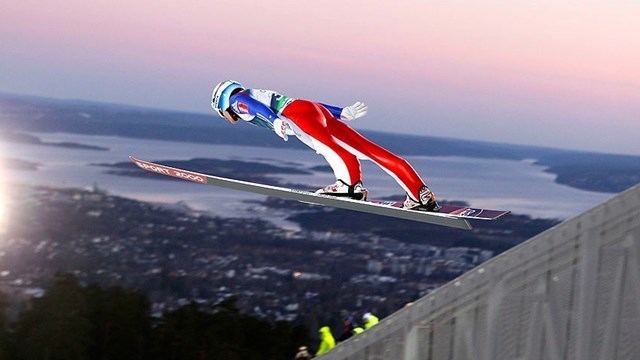 | ||
Highest governing body International Ski Federation (FIS) Team members M Individual (50)L Individual (40)Team event (4) Venue AsiaEuropeNorth America | ||
Top 3 olympic ski jumping appearances
Ski jumping is an Olympic winter sport which was firstly contested in Norway in the late 19th century, and later spread through Europe and North America in the early 20th century.
Contents
- Top 3 olympic ski jumping appearances
- History
- Hills
- Scoring system
- Judges
- Techniques
- Major competitions
- Winter Olympic Games
- World Ski Championships
- Ski Flying World Championships
- World Cup
- Other competitions
- Womens participation
- 2014 Olympic Games
- Historic jumps
- Perfect score jumps 5 x 20
- Notable ski jumpers
- References
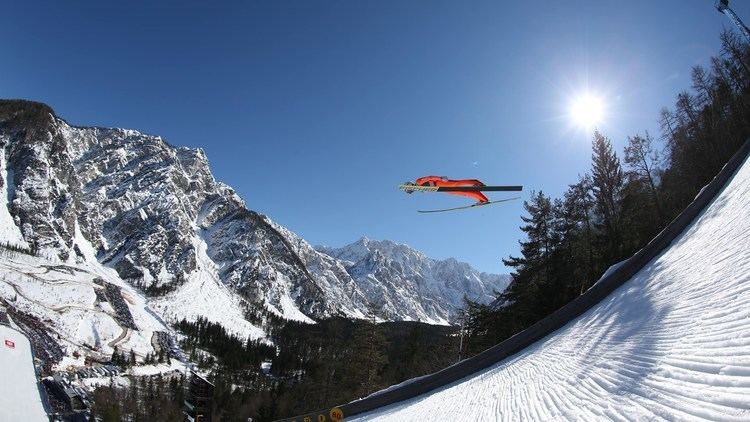
The ski jumping venue consists of the jumping ramp (in-run), take-off table, and a landing hill. Each jump is evaluated according to the distance traveled and the style performed. The distance score is related to the construction point (also known as the K-point), which is a line drawn in the landing area and serves as a "target" for the competitors to reach. The score of each judge evaluating the style can reach a maximum of 20 points.
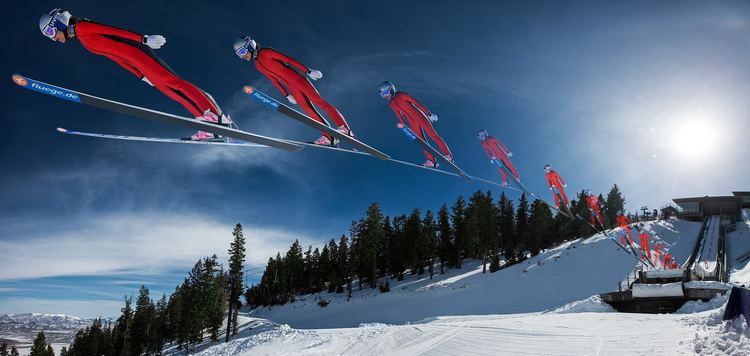
The jumping techniques has evolved over the years, from jumps with the parallel skis with both arms pointing forwards, to the "V-style", which is widely used today.
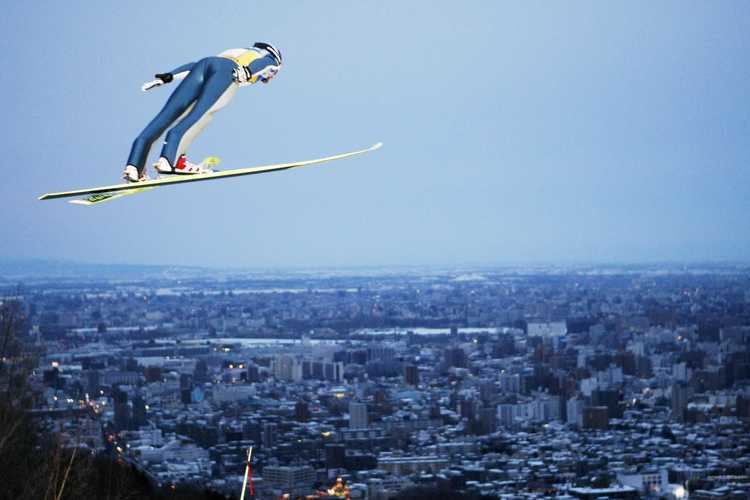
Ski jumping has been included at the Winter Olympics since 1924 and at the FIS Nordic World Ski Championships since 1925. Women's participation in the sport began in the 1990s, while the first women's event at the Olympics has been held in 2014. All major ski jumping competitions are organised by the International Ski Federation. Stefan Kraft holds the official record for the longest ski jump with 253.5 metres (831 ft), set in Vikersund in 2017.

Ski jumping can also be performed in the summer on an in-run where the tracks are made from porcelain and the grass on the slope is covered with plastic, combined with water. The highest level summer competition is the FIS Ski Jumping Grand Prix, contested since 1994.
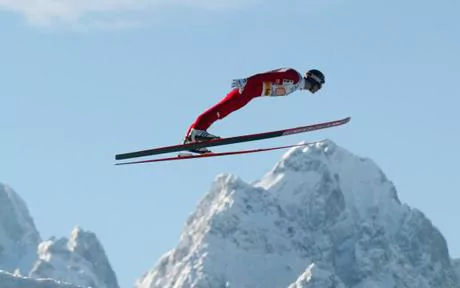
History
Like most of the Nordic skiing disciplines, the first ski jumping competitions were held in Norway in the 19th century, although the evidence of ski jumping in the late 18th century exist. The recorded origins of the first ski jump traces back to 1808, when Olaf Rye reached 9,5 metres (31 feet). Sondre Norheim, who is regarded as the "father" of the modern ski jumping, won the first-ever ski jumping competition with prizes, which was held in Høydalsmo in 1866.
The first larger ski jumping competition was held on Husebyrennet hill in Oslo, Norway, in 1875. The event was moved to Holmenkollen in 1892 due to the poor infrastructure and the weather conditions, and is today still one of the main ski jumping events in the season.
In the late 19th century, Sondre Norheim and Nordic skiier Karl Hovelsen emigrated to the United States and started developing the sport in the country. In 1924, ski jumping was featured at the 1924 Winter Olympics in Chamonix, France. The sport has been featured at the every Olympics since then.
In 1935, the origins of the ski flying began in Planica, Slovenia, where Josef Bradl became the first competitor in the history to jump over 100 metres. At the same venue, the first official jump over 200 metres was achieved in 1994, when Toni Nieminen landed at 203 metres.
In 1964 in Zakopane, Poland, the large hill event was introduced at the FIS Nordic World Ski Championships. In the same year, the normal hill event was included on the Olympic programme at the 1964 Winter Olympics. The team event was added later, at the 1988 Winter Olympics.
In 1990, qualifiers for the main event were introduced to limit the number of competitors.
Hills
The slopes are composed of the built-in ramp (or inrun) and the hill (natural or artificial) and are classified according to the distance that the competitors travel in the air, between the end of the table and the landing. Each hill has a construction point (K-point), which serves as a "target" that the competitors must reach. The classification of the hills are as follows:
Scoring system
The winner is decided with a scoring system based on distance, style, inrun length, gate factor and wind conditions. In the individual event, the scores from each skier's two competition jumps are combined to determine the winner. Aerodynamics has become a factor of increasing importance in modern ski jumping, with recent rules addressing the regulation of ski jumping suits.
Distance score depends on the hill's K-point. For K-90 and K-120 competitions, the K-point is set at 90 metres (300 ft) and 120 metres (390 ft), respectively. Competitors are awarded 60 points (normal and large hills) and 120 points (flying hills) if they land on the K-point. For every metre beyond the K-point, the competitor is awarded extra points; the typical value is 2 points per metre in small hills, 1.8 points in large hills and 1.2 points in ski flying hills.
Gate factor is a scoring compensation for variable outdoor conditions. Aerodynamics and take-off speed are important variables that determine the value of a jump, and if weather conditions change during a competition, the conditions will not be the same for all competitors. The competitor receive or lose points if the inrun (or start gate) length is adjusted to provide optimal take-off speed. Points are added when the starting gate is moved up, and withdrawn when the gate is lowered.
An advanced calculation also determines compensation points for the actual unequal wind conditions at the time of the jump. These points are added or withdrawn from the original scores of the individual jump according to the wind conditions; when there is back wind, the points are added, and when there is front wind, the points are withdrawn. Wind speed and direction are measured at five different points based on average value, which is determined before every competition.
If two or more competitors finish the competition with the same number of points, they are given the same placing and receive same prizes. Ski jumpers below the minimum safe body mass index are penalized with a shorter maximum ski length, reducing the aerodynamic lift they can achieve. These rules have been credited with stopping the most severe cases of underweight athletes, but some competitors still lose weight to maximize the distance they can achieve.
Judges
During the competition, five judges are based in a tower to the side of the expected landing point. They can award up to 20 points each for jumping style, based on keeping the skis steady during flight, balance, optimal body position, and landing. The highest and lowest style scores are disregarded, with the remaining three scores added to the distance score.
Techniques
Each jump is divided into four parts: in-run, take-off (jump), flight, and landing.
By using the V-style, firstly pioneered by Swedish ski jumper Jan Boklöv in the mid-1980s, skiers are able to exceed the distance of the take-off hill by about 10% compared to the previous technique with parallel skis. Previous techniques included the Kongsberger technique, the Däescher technique and the Windisch technique. Until the mid-1960s, the ski jumper came down the in-run of the hill with both arms pointing forwards. This changed when the Däscher technique was pioneered by Andreas Däscher in the 1950s, as a modification of the Kongsberger and Windisch techniques.
The landing requires the skiers to touch the ground in the Telemark landing style (Norwegian: telemarksnedslag), named after the Norwegian county of Telemark. This involves the jumper landing with one foot in front of the other, mimicking the style of Telemark skiing. Failure to comply with this regulation leads to the deduction of style points, issued by the judges.
Major competitions
All major ski jumping competitions are organized by the International Ski Federation.
Winter Olympic Games
The large hill ski jumping event was included at the Winter Olympic Games for the first time in 1924, and has been contested at every Winter Olympics since then. The normal hill event was added in 1964. Since 1992, the normal hill event is contested at the K-90 size hill; previously, it was contested at the K-60 hill. Women's debuted at the Winter Olympics in 2014.
World Ski Championships
The ski jumping at the FIS Nordic World Ski Championships was firstly contested in 1925. The team event was introduced in 1982, while the women's event was firstly held in 2009.
Ski Flying World Championships
The FIS Ski Flying World Championships was firstly contested in 1972 in Planica.
World Cup
The FIS Ski Jumping World Cup is contested since the 1979–80 season.
Other competitions
Other competitions, organised by the International Ski Federation, include the FIS Ski Jumping Grand Prix, Continental Cup, FIS Cup, FIS Race, and Alpen Cup.
Women's participation
In January 1863 in Trysil, Norway, at that time 16 years old Norwegian Ingrid Olsdatter Vestby, became the first-ever known female ski jumper, who participated in the competition. Her distance is not recorded.
Women began competing at the high level since the 2004–05 Continental Cup season. International Ski Federation organized three women's team events in this competition and so far the only team events in history of women's ski jumping.
Women's made a premiere FIS Nordic World Ski Championships performance in 2009 in Liberec. The first world champion became American ski jumper Lindsey Van.
In the 2011–12 season, women's competed for the first time in the World Cup. The first event was held on 3 December 2011 at Lysgårdsbakken at normal hill in Lillehammer, Norway. The first-ever female World Cup winner was Sarah Hendrickson, who also became the inaugural women's World Cup overall champion. Previously, women had only competed in Continental Cup seasons.
2014: Olympic Games
In 2006, the International Ski Federation proposed that women could compete at the 2010 Winter Olympics, but the proposal was rejected by the IOC because of the low number of athletes and participating countries at the time.
A group of fifteen competitive female ski jumpers later filed a suit against the Vancouver Organizing Committee for the 2010 Olympic and Paralympic Winter Games on the grounds that it violated the Canadian Charter of Rights and Freedoms since men were competing. The suit failed, with the judge ruling that the situation was not governed by the charter.
A further milestone was reached when women's ski jumping was included as part of the 2014 Winter Olympics at normal hill event. The first Olympic champion was Carina Vogt.
Historic jumps
Note: Only official results are listed, invalid jumps are not included.
Perfect score jumps: 5 x 20
Those who have managed to show a perfect jump, which means that all five judges attributed the maximum style score of 20 points for their jumps. Kazuyoshi Funaki, Sven Hannawald and Wolfgang Loitzl were attributed 4x20 (plus another 19.5) style score points for their second jump, thus receiving nine times the maximum score of 20 points within one competition. Kazuyoshi Funaki is the only one in history who achieved this more than once. So far only seven jumpers are recorded to have achieved this score in total of ten times:
Notable ski jumpers
To be included in the list, the male athlete needs to either win at least 20 individual World Cup events, have at least 400 individual starts in the World Cup, or win three or more medals at the Winter Olympics. The female athlete needs to either win at least 10 individual World Cup events or win the medal at the Winter Olympics.
